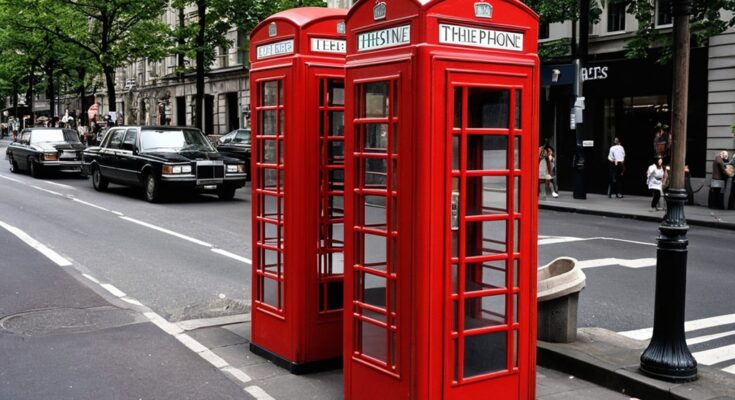The Enduring Charm of the Phone Booth: A Look at Its Past, Present, and Future
In a world dominated by smartphones and constant connectivity, it’s hard to imagine a time when the humble phone booth was a vital part of daily life. However, this seemingly outdated relic from the past continues to hold a special place in the hearts of many, symbolizing a time when communication was more intentional and less instantaneous.
This blog post explores the fascinating history of the phone booth, its cultural significance, and how these iconic structures are still relevant in today’s fast-paced world. Whether you’ve used one in the past or simply appreciate its nostalgic value, this article is for you!
The Origins of the Phone Booth
The phone booth, also known as a phone box, traces its origins back to the late 19th century. The first telephone booth was created by William Gray in 1878, though it was quite different from the phone booths we think of today. His booth, installed in Hartford, Connecticut, was essentially an enclosure designed to house a payphone, offering some level of privacy for users.
In the early 20th century, the concept of the phone booth evolved further, with telephone companies beginning to install enclosed booths in public spaces. This offered people the opportunity to make calls in private while also paying for their phone calls. Phone booths soon became a staple of urban landscapes, providing an essential service to people on the go. Whether in cities or small towns, these structures dotted the streets and offered a temporary escape from the hustle and bustle of the world outside.
The Golden Age of the Phone Booth
As telecommunication technologies improved, the phone booth evolved into a recognizable and essential part of public infrastructure. The 1950s through the 1980s were often regarded as the “golden age” of the phone booth. These were the years when the phone booth was ubiquitous, serving as a vital point of contact for anyone without access to a landline phone.
The phone booth had a special place in American and British pop culture. In the United States, the phone booth was often depicted in movies and TV shows, becoming a symbol of communication and sometimes even a symbol of personal isolation. The red British telephone booths, which are still instantly recognizable today, became synonymous with the UK’s commitment to providing reliable communication.
People would line up at these booths during their lunch breaks, make a quick call to family members, or use it to meet friends. It wasn’t uncommon for individuals to engage in brief, yet meaningful, conversations from the confines of the booth. In addition, the rise of the payphone within these booths offered an affordable way for people to communicate without relying on landline services.
Decline and the Rise of Mobile Phones
Despite their widespread use, the popularity of the phone booth began to wane in the late 1990s and early 2000s. The introduction of mobile phones, combined with their increasing affordability and widespread use, made the phone booth less relevant. People no longer had to wait in line or struggle to find loose change to make a call. Instead, they carried their phones with them at all times, making the traditional phone booth redundant.
At the same time, advances in mobile network technology, such as the introduction of text messaging and internet access on phones, provided even more ways to communicate, further diminishing the need for landline connections. As a result, many phone booths were either removed or repurposed for other uses.
The Nostalgic Appeal of the Phone Booth
Even though the phone booth has all but disappeared from many urban areas, it remains a nostalgic symbol for many. The iconic red British phone booths, in particular, have become a significant part of London’s cultural identity. They can be found in various tourist hotspots, often photographed by tourists as a reminder of a simpler time.
Similarly, American cities such as New York still feature remnants of the once-ubiquitous phone booths. Though many have been replaced with new, more modern payphones or charging stations, the idea of the phone booth still carries a sense of nostalgia for many who remember the days when they were essential for staying connected.
The Modern Reinvention of the Phone Booth
Despite the decline in their use, phone booths aren’t entirely a thing of the past. In some places, phone booths are being repurposed to meet the needs of the modern world. For instance, in major cities around the world, phone booths have been reimagined as Wi-Fi hotspots, providing free internet access to those who need it. These modern booths often feature interactive screens that offer various services, such as the ability to make voice or video calls, access maps, or find information about local businesses.
The phone booth has also made a surprising comeback in the form of private spaces within public areas. Some cities have turned old phone booths into mini pods or small workstations, where individuals can make private calls or get some work done. These spaces are often designed with soundproofing in mind to ensure that the user has the privacy they need.
In addition, there are artistic and creative uses for old phone booths. In some places, phone booths have been converted into mini libraries, providing people with the opportunity to take or leave books for free. Others have been turned into tiny urban gardens, giving people the chance to grow flowers or plants in an otherwise unutilized space.
The Environmental Impact of Phone Booths
While the majority of phone booths have been replaced by mobile phones or repurposed for modern uses, their environmental impact is a factor worth considering. Originally, phone booths were made with durable materials such as metal and glass. In many instances, the materials used in these booths were recyclable, helping to reduce their ecological footprint when they were dismantled.
The trend of repurposing old phone booths can also be seen as an environmentally conscious effort. By transforming phone booths into functional spaces or artistic installations, cities are finding creative ways to reuse existing infrastructure and reduce waste. Additionally, many of these new uses – such as Wi-Fi hotspots or mini libraries – contribute positively to local communities.
Phone Booths in Popular Culture
Throughout the years, phone booths have been prominently featured in films, TV shows, and literature, often serving as a symbol of communication, secrecy, or even escape. One of the most famous examples is the 1960s TV show The Twilight Zone, in which characters would often find themselves trapped inside a phone booth or relying on one for crucial communication.
In modern films and media, phone booths continue to be a symbol of a bygone era. In movies such as Phone Booth (2002), the phone booth is not just a place to make calls, but a place where tension and drama unfold, turning an everyday object into a focal point for suspense and thrill.
Why the Phone Booth Still Matters Today
So, why does the phone booth still matter in the digital age? The simple answer is that it represents a time when communication was more intentional and less instant. In the world of texting, social media, and video calls, the phone booth reminds us of a time when we had to pause and make an effort to connect with others.
Additionally, phone booths symbolize the balance between public and private spaces. They provided individuals with a temporary moment of solitude and privacy in otherwise crowded and noisy public environments. Even today, the idea of having a small, private area in a busy world is something that resonates with many people.
Conclusion
While phone booths may not play the same prominent role in society that they once did, they continue to carry cultural and historical significance. From their origins as simple enclosures for payphones to their reinvention as creative, modern spaces, phone booths are a reminder of a time when communication was slower, more deliberate, and deeply personal. They symbolize our desire for connection in a world that is constantly changing, offering us a glimpse of the past while also pointing the way toward the future.
The phone booth may be a relic of a bygone era, but it remains a piece of our collective history. Whether you remember using one in your youth or have only seen them in photos or movies, the phone booth continues to evoke feelings of nostalgia, curiosity, and wonder. It stands as a testament to how far we’ve come in our ability to connect with one another – and a reminder that sometimes, even in an age of instant communication, we still long for a little bit of privacy and peace amidst the chaos of the modern world.




